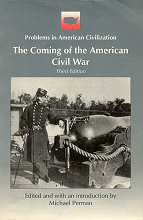
The coming of the American Civil War (előszó)
This anthology first appeared in 1961 under the title The Causes of the American Civil War. It proved to be one of the most widely used volumes in the Problems in American Civilization series, known popularly as the Heath books or the Amherst series. The author was Edwin C. Rozwenc of Amherst College, who was also general editor of the series and the editor of seven of its volumes. In 1972 Professor Rozwenc published a second edition. Now, twenty years later, a thoroughly revised and updated version appears, and I am pleased and honored to be the new author.
Retitled The Coming of theAmerican Civil War, the new edition follows the format of the original Rozwenc versions. That is, it arranges the readings chronologically so as to show how the inter pretation of the origins of the Civil War has changed over the intervening century and a half. Unlike its predecessors, however, this edition gives far less attention to the writings of the first hundred years. These earlier explanations occupy only about a fourth of the book, and they comprise just seven selections—all of them quite brief. The first three pieces were written by contemporaries who themselves played prominent roles in the sectional conflict. The next four essays come from professional historians writing between 1910 and 1960, all of whom were participating in a scholarly debate over whether the contest between North and South involved deepseated and fundamental issues or whether their differences were less basic and therefore capable of resolution.
The rest of the anthology features selections by historians of the past generation or so. Thus far, their work has not been classified as a school, unlike the writings of proponents of the "irrespressible conflict," who have been identified as the traditional school, and their rivals, the revisionists, who espoused the "repressible conflict" approach. An argument can be made—and I shall make it in the Introduction—that these recent interpretations do actually have a sufficient amount in common that they can be categorized as a distinct group. To give them coherence in this anthology, I have divided them according to the particular approach each author has taken, namely, political and institutional, social and economic, or cultural and ideological. I have also created a fourth category, topical in nature, exploring the secession crisis of 1860–1861 that brought the sectional conflict to a climax. Because the secession crisis precipitated the outbreak of war, this short-term, proximate cause of the Civil War needs to be separated from the long-term origins of the sectional dispute itself.
One additional comment on the selections is that, because of this collection's emphasis on the causes of the Civil War, I have limited myself to essays that shed light on the conflict's origins. I considered writings on other aspects of the history of the United States before the war to be inappropriate and irrelevant, even though many interesting topics could have been included if I had contemplated a reader of such broad scope and coverage. Had this book strayed beyond the focus on causes, however, it would alinost certainly have become so wide-ranging and diverse as to be of little use. Moreover, it would no longer have been the third edition of Edwin C. Rozwenc's original anthology.
Finally, I want to thank those historians who evaluated the outline of this new edition. Some of them endured a second round of this process and are therefore doubly in my debt. These reviews were very helpful indeed, because the reactions and suggestions they generated gave me a good sense of what other scholars and teachers see as the most important and useful writings on this subject. I am most grateful for the help offered by Richard H. Abbott, Eastern Michigan University; O. Vernon Burton, University of Illinois at Urbana-Champaign; Mary A. DeCredico, United States Naval Academy; Paul D. Escott, Wake Forest University; John M. McCardell, Middlebury College; Robert E. May, Purdue University; Lawrence N. Powell, Tulane University; and Harry L. Watson, University of North Carolina at Chapel Hill. I should add that this advice was given anonymously; the names are revealed only so that those who participated could be thanked publicly. One of my colleagues at the University of Illinois at Chicago, Richard John, also offered good suggestions, and I want to thank him for his interest in the project.
Others whom I would like to thank for their help with this book are Olivia Mahoney and Eileen Flanagan of the Chicago Historical Society and the editorial staff at D. C. Heath: Carolyn Ingalls, Karen Myer, Margaret Roll, and especially Sylvia Mallory, who was wonderfully supportive and thorough as always. And to my wife, Karen, thanks for everything.
M. P.